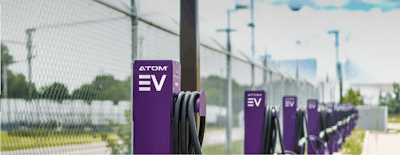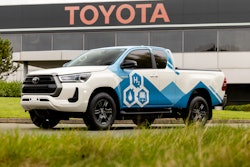
Charging infrastructure is one of the biggest challenges the electric vehicle industry faces today, especially as it relates to heavy-duty use cases. But with environmental and sustainability goals pushing the wave of adoption forward, a greater embrace of EVs among the trucking industry will eventually come to fruition.
Companies like Geotab and Atom Power are working to accelerate the broad adoption of EVs for fleets. Geotab, with its open platform and marketplace connecting commercial vehicles to the cloud and providing data-driven analytics to help customers better manage their fleets, partnered with Atom Power, creator of the commercial UL-listed digital solid-state circuit breaker, a year ago to give fleet managers access to complex fleet analytics and EV charging infrastructure to make their transition toward electrification simpler and more cost-effective.
The integration wasn’t simply a matter of Geotab customers having access to Atom Power’s user interface via the Geotab platform. It goes deeper than that. Atom Power integrated their data directly into the Geotab platform.
This gives mutual customers insights into charging station data from Atom Power and vehicle data from Geotab. For example, Geotab can geofence around an Atom Power charging depot on a map and, with vehicle tracking, can show that a certain vehicle is docked at that station. If vehicle data shows that it hasn’t been charged within a certain timespan, a fleet or depot manager can be notified so they can look at station data to troubleshoot any issues.
“That data is available to them in a single pane of glass,” said Eric Mallia, Geotab vice president of sustainability solutions. “Having all this centralized information, taking advantage of what Atom Power’s data can deliver and combining it with MyGeotab features and functionalities like data on a map, the rules and alerts, really enables more functionality than either of us can do separately on our own.”
Since the partnership went into effect last November, the two companies continue to expand their combined capabilities, letting customers take the lead by listening to their needs, Mallia said.
Geotab’s diverse customer base of 4 million platform subscribers includes 20% to 25% heavy duty commercial fleets. Because of its partnership with Atom Power, Mallia said Geotab realized the need to expand its ecosystem to include additional partners as it relates to EV fleet management.
Atom Power’s breaker lends itself to scale for fleets and workplace charging, which are the company’s target markets, said Atom Power CEO Ryan Kennedy. Many utilities cannot sustain more than a couple of EV charging stations, but Atom Power’s application is a bit different. The company provides a pedestal for a vehicle to plug into, but Kennedy said there is very little inside the pedestal other than wire and termination blocks. The charging function happens back at the electrical panel, usually located somewhere else on site rather than at the station itself.
“For us, it was kind of like, the world can continue making specific use products for specific applications, or you can create a circuit breaker that can be told what it is, such as an EV charger,” he said. “Atom Power is a breaker and panel provider, but the company has evolved to be heavy into energy management and on-premise energy management control systems, as well as facility-driven software.”
That includes overlaying Atom Power’s energy management software solution with partners that provide DC fast charging that can go up to 400 kilowatts for larger vehicles. Kennedy said the fleets his company focuses largely on are in the last-mile delivery sector, running vans and box trucks that utilize Level 2 chargers.
He said Level 2 is where the larger market is right now, but he could see Atom Power moving into heavier duty vehicles eventually.
“We kind of expect to be in that space, but we're just keeping our eye on it right now to see where it's landing and how, especially vehicles of the Class 8 size get utilized electrically. That's one of the interesting things about this space: the usage of the vehicles changes a bit based on them being electric,” Kennedy said. “I think we have to let the market kind of pan out a little bit more there … because it's very early on, especially Class 8.”









